The BEST4Hy H2020 project, first project results
An international partnership developing technologies for the recovery of critical raw materials from hydrogen technologies
An international partnership developing technologies for the recovery of critical raw materials from hydrogen technologies
An international partnership developing technologies for the recovery of critical raw materials from hydrogen technologies
Despite Covid 19 restrictions and consequences, BEST4Hy (SustainaBlE SoluTions FOR recycling of end-of-life Hydrogen technologies) project team has successfully carried out the first six months of research activities. BEST4Hy project focuses on the development and validation of existing and novel recycling processes for two key fuel cell and hydrogen products: proton exchange membrane fuel cells (PEM FC) and solid oxide cells (SOC) including both fuel cells (SOFC) and electrolysis cells (SOEC). The project aims to adapt two existing recycling processes applied already to other technologies and to validate a novel dismantling process for PEMFC. Furthermore, a novel SOC recycling technology will be tested. The materials issued from the processes will be validated in terms of quality and performance when re-used in new components and in new stacks, demonstrating the overall efficiency of recycling. Ambitious targets for recycled content in new stacks/cells have been set and will be validated by fuel cell producers, to prove the viability of higher value, closed loop recycling. Environmental impact and cost-benefits evaluations on the proposed technologies will be performed. This will support a more efficient use of raw materials, including critical resources, and it will contribute to improve the end-of-life treatment of the hydrogen technologies and to foster a circular economy approach within the sector.
During the first six months, Hensel Recycling focused on the validation of existing and novel technologies for PEMs recycling. The main activities have been the manual dismantling of the stacks with removal of layers, sealings, CCM/electrodes.
Moreover, a mechanical dismantling was performed with an ad hoc equipment (rotating knives shredder); this machine is typically used to shred metallic and composite materials and is ideal to reduce volume and separate fractions smoothly.
However, the recovered product was not satisfactory, as the recovered fractions stick together the purity of the ink and carbon paper. In contrast, manual processing issues different parts perfectly separated. Hensel Recycling plan to deepen this topic and continue to explore possibilities of a more efficient mechanical shredding and separation, changing boundary conditions, working towards automation of the dismantling process.
On the other hand, CEA advanced its work with tests based on vapor phase for separating the different components of MEA. Thanks to these experiments, CEA validated the dismantling concept even for MEA with sealing in liquid phase at high pressure. Some modifications on test bench are required to promote preferential path of vapor phase through the GDL.
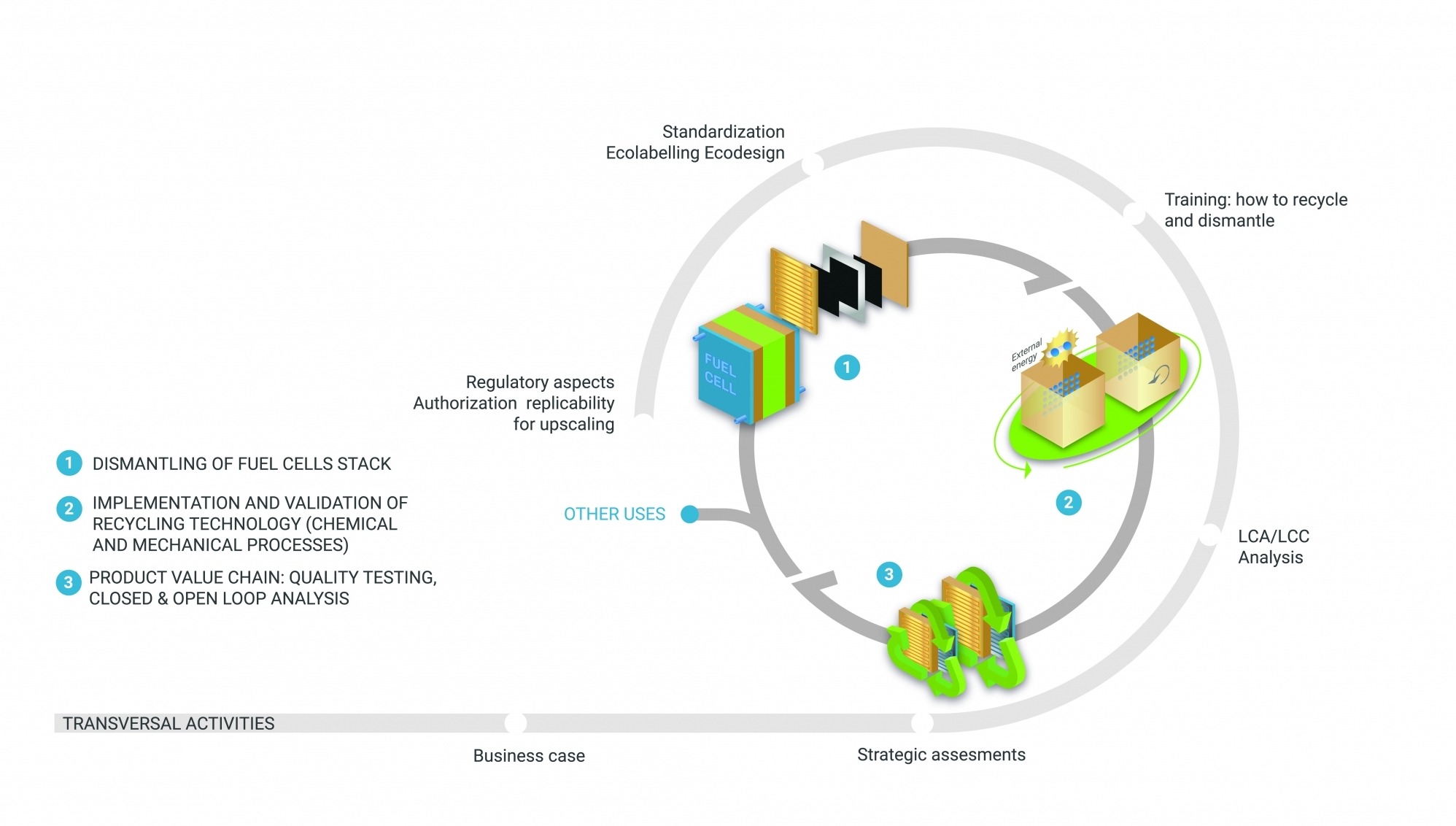
For the next months, an evaluation of high-pressure process in vapor phase is planned with a possible validation of the concept using complete stack of MEA’s.
In parallel POLITO team worked on the selection of existing technologies for the recovery of SOCs. This task is focused on the recovery of fuel electrode components to obtain recycled materials for cells re-manufacturing. Currently POLITO has started the activity related to the selective recovery of Ni from Ni-YSZ composite and to this aim two different approaches have been already identified, the first based on leaching through mineral acid solutions (i.e. HNO3) and a second one involving the use of EDTA as chelating agent and its possible recovery by mild acidification.
Beside the evaluation of the most effective recovery approach, the combination of the recovery step with the hydrothermal treatment (needed to disaggregate the anode component)) will be studied in order to minimize the number of sequential operations for the further effective translation of the overall process form TRL3 to TRL5.
Innovative EoL processes for LSC air electrode based on selective recover of lanthanum (rare earth and expensive metal) and cobalt (as critical raw material) have also been investigated. In particular the main result reached is the characterization of the the LSC materials from EoL and pristine cells. Mechanical detachment and milling of LSC protective layer and air electrode are being optimized.
In the meanwhile, University of Ljubljana is working on Inventory tables for the manufacturers and EoL development technologies’ partners to collect useful information for LCA and LCC analysis.
Envipark is also formalizing the Advisory Board membership. Advisory Board members confirmed to date include fuel cells materials providers, hydrogen systems manufacturers and users in the automotive and naval sector, recyclers, energy and hydrogen research centers and academic institutes.
Concerning the communication and dissemination activities, the project website is online (www.best4hy-project.eu/) as well as social media channels (Linkedin and Twitter).
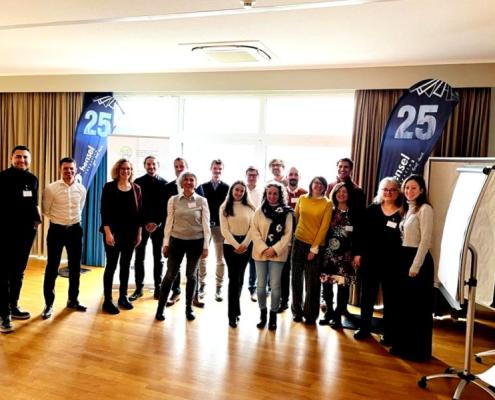 https://best4hy-project.eu/wp-content/uploads/2023/12/FINAL-EVENT-PIC.png
600
800
monica
https://best4hy-project.eu/wp-content/uploads/2021/04/LOGO.png
monica2023-12-20 12:59:552023-12-20 13:06:58BEST4Hy Closes the loop: final event and achievements on the End-of-life hydrogen fuel cells recycling project
https://best4hy-project.eu/wp-content/uploads/2023/12/FINAL-EVENT-PIC.png
600
800
monica
https://best4hy-project.eu/wp-content/uploads/2021/04/LOGO.png
monica2023-12-20 12:59:552023-12-20 13:06:58BEST4Hy Closes the loop: final event and achievements on the End-of-life hydrogen fuel cells recycling project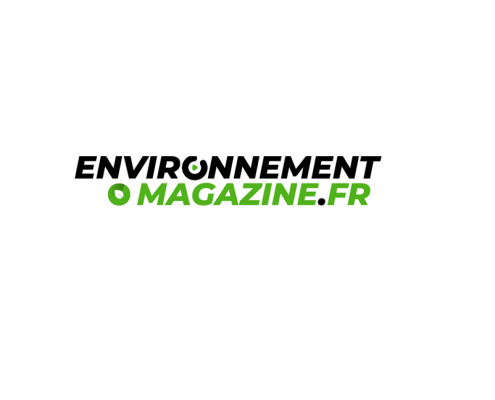 https://best4hy-project.eu/wp-content/uploads/2023/12/mat-1.png
648
1152
monica
https://best4hy-project.eu/wp-content/uploads/2021/04/LOGO.png
monica2023-12-07 17:44:232023-12-07 17:54:32BEST4Hy in Mat Environnement Magazine
https://best4hy-project.eu/wp-content/uploads/2023/12/mat-1.png
648
1152
monica
https://best4hy-project.eu/wp-content/uploads/2021/04/LOGO.png
monica2023-12-07 17:44:232023-12-07 17:54:32BEST4Hy in Mat Environnement Magazine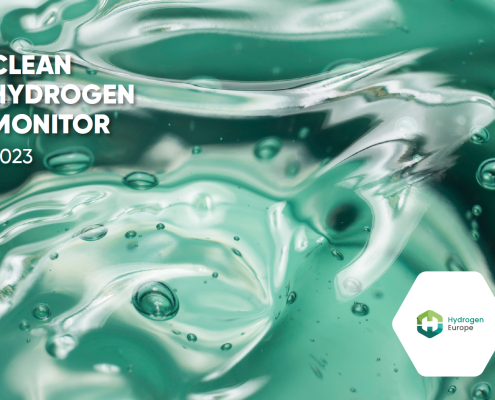 https://best4hy-project.eu/wp-content/uploads/2023/11/CleanH2Monitoring.png
993
1401
monica
https://best4hy-project.eu/wp-content/uploads/2021/04/LOGO.png
monica2023-11-22 14:57:182023-11-22 14:58:02Clean H2 Monitor 2023
https://best4hy-project.eu/wp-content/uploads/2023/11/CleanH2Monitoring.png
993
1401
monica
https://best4hy-project.eu/wp-content/uploads/2021/04/LOGO.png
monica2023-11-22 14:57:182023-11-22 14:58:02Clean H2 Monitor 2023
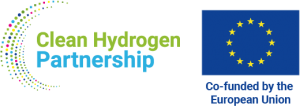
This project has received funding from the Fuel Cells and Hydrogen 2 Joint Undertaking (now Clean Hydrogen Partnership) under Grant Agreement No 101007216. This Joint Undertaking receives support from the European Union’s Horizon 2020 Research and Innovation program, Hydrogen Europe and Hydrogen Europe Research.
© 2022 All rights reserved. PI 07154400019 Privacy and Cookie Policy

 BEST SUCCESS STORY AWARD
BEST SUCCESS STORY AWARD